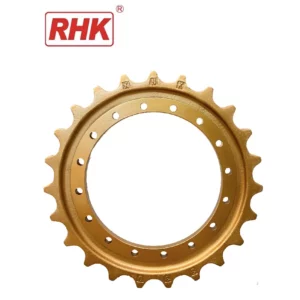Working with excavator sprockets involves potential hazards, so it’s crucial to follow safety precautions to prevent accidents and injuries.
Here are some safety measures to consider when working with excavator sprockets:
- Equipment Inspection: Before starting work, inspect the excavator sprockets and associated components for signs of wear, damage, or defects. Ensure that the sprocket teeth are in good condition and free from cracks or excessive wear. Check for loose bolts, damaged mounting hardware, or any other issues that may affect the safe operation of the sprocket.
- Personal Protective Equipment (PPE): Wear appropriate PPE, including safety glasses or goggles, steel-toed boots, gloves, and hearing protection when working with excavator sprockets. PPE helps protect against flying debris, sharp edges, crushing hazards, and noise-related injuries.
- Lockout/Tagout: Before performing maintenance or repair work on the excavator sprockets, follow lockout/tagout procedures to isolate the equipment’s power source and prevent accidental startup. Lockout/tagout ensures that the excavator cannot be operated while work is being performed, reducing the risk of injury from moving parts.
- Secure Work Area: Ensure that the work area is clear of debris, tools, excavator Sprocket manufacturers and other obstacles that could pose tripping hazards or interfere with equipment operation. Secure the excavator on stable ground or use outriggers to stabilize the machine if necessary.
- Safe Access: Use ladders, platforms, or other appropriate access equipment to safely access the excavator sprockets for maintenance or inspection. Avoid climbing on the equipment or standing on unstable surfaces, as this can increase the risk of falls and other accidents.
- Proper Tools: Use the correct tools and equipment for the job, including wrenches, sockets, and torque wrenches. Ensure that tools are in good condition and properly maintained to prevent accidents and injuries during use.
- Safe Handling: Exercise caution when handling heavy components such as sprockets, chains, and bolts. Use proper lifting techniques and mechanical lifting aids as needed to avoid strain or injury. Avoid placing hands or fingers near moving parts, and never reach into or around the sprocket assembly while the equipment is in operation.
- Follow Manufacturer Guidelines: Adhere to the manufacturer’s recommendations and guidelines for servicing, maintenance, and replacement of excavator sprockets. Follow proper installation procedures and torque specifications to ensure safe and reliable operation of the equipment.
- Training and Supervision: Ensure that personnel working with excavator sprockets are properly trained and supervised. Provide training on safe work practices, equipment operation, and emergency procedures to reduce the risk of accidents and promote a culture of safety in the workplace.
- Emergency Preparedness: Be prepared for emergencies by having first aid kits, fire extinguishers, and emergency communication devices readily available. Establish emergency response procedures and ensure that all personnel are familiar with the protocols for reporting accidents, injuries, or equipment malfunctions.
By following these safety precautions, workers can minimize the risk of accidents and injuries when working with excavator sprockets, ensuring a safe and productive work environment on construction sites.
How do excavator Sprocket contribute to fuel efficiency in heavy machinery?
Excavator sprockets indirectly contribute to fuel efficiency in heavy machinery by optimizing the performance and efficiency of the undercarriage system. While sprockets themselves do not directly affect fuel consumption, their proper functioning ensures that the excavator operates smoothly and efficiently, which can have a positive impact on fuel usage. Here’s how excavator sprockets contribute to fuel efficiency:
- Reduced Resistance: Sprockets are part of the drive system that transfers power from the engine to the tracks. When sprockets are in good condition and properly aligned, they minimize resistance and friction between the track chain and the ground surface. Reduced resistance means that the engine doesn’t have to work as hard to propel the excavator forward, resulting in lower fuel consumption.
- Optimized Traction: Properly maintained sprockets help ensure optimal traction between the tracks and the ground surface. Good traction allows the excavator to move efficiently over various terrains, including soft soils, loose gravel, and steep slopes, without excessive slippage or wheel spin. By maintaining traction, sprockets help prevent energy waste and fuel consumption associated with ineffective movement and slipping tracks.
- Smooth Operation: Sprockets play a role in providing smooth and consistent movement of the track chain. When sprockets are worn or misaligned, they can cause vibrations, jolts, and uneven movement of the tracks, which not only reduce operator comfort but also lead to inefficiencies in engine performance. Smooth operation reduces the need for constant acceleration and deceleration, helping to conserve fuel during equipment operation.
- Proper Track Tension: Sprockets contribute to maintaining proper track tension in the undercarriage system. Correct track tension ensures that the tracks are securely positioned on the track frame and maintain consistent contact with the ground surface. excavator Sprocket suppliers Proper tension minimizes track slippage and prevents excessive wear on the track components, reducing the energy required to propel the excavator and improving fuel efficiency.
- Enhanced Component Lifespan: Well-maintained sprockets help extend the lifespan of other undercarriage components, such as track chains, rollers, and idlers. When sprockets are in good condition, they distribute the load evenly along the track chain, reducing stress and wear on individual components. By minimizing wear and tear, sprockets help optimize the performance of the undercarriage system and reduce the frequency of maintenance and replacement, leading to long-term fuel savings.
Overall, while excavator sprockets themselves do not directly consume fuel, their proper maintenance and functioning contribute to optimizing the performance and efficiency of the undercarriage system. By reducing resistance, optimizing traction, ensuring smooth operation, maintaining proper track tension, and enhancing component lifespan, sprockets indirectly help improve fuel efficiency in heavy machinery such as excavators. Regular inspection, lubrication, and maintenance of sprockets are essential for maximizing their contribution to fuel savings and overall equipment performance on construction sites.

Comments